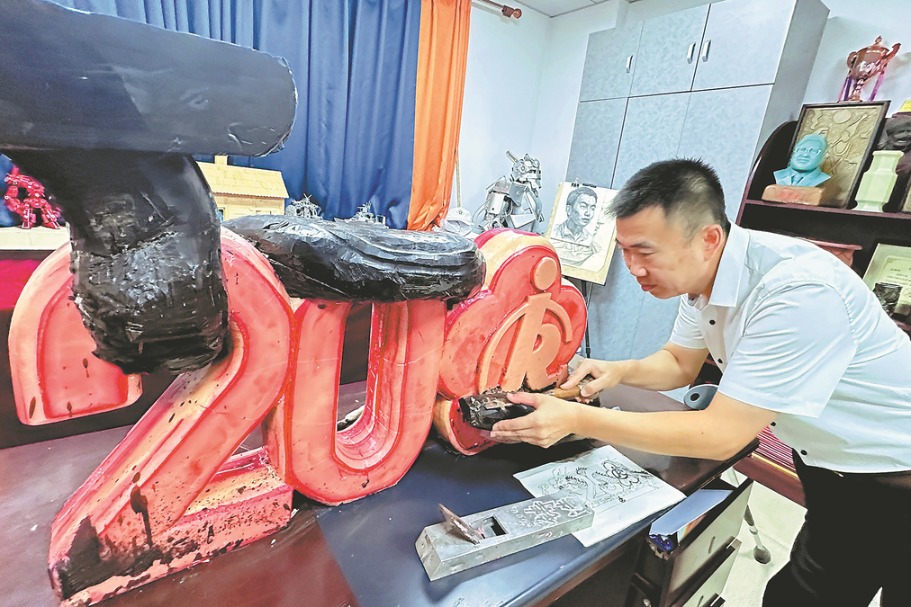China steps up preservation of Flying Tigers relics


BEIJING -- In a memorial hall in Zhijiang, a small county in Central China's Hunan province, 69-year-old Rick Peterson lingered before a display of jackets, flashlights and faded snapshots, his eyes reflecting both wonder and grief as the relics told the story his father had lived, the legendary saga of the Flying Tigers.
"Seeing some of the supplies, equipment and pictures like these, which show what he was doing, was really, really emotional," Peterson said.
During World War II (WWII), Peterson's father served with the Flying Tigers, a group of American volunteer pilots who fought alongside Chinese forces against Japanese invaders, forging a friendship that withstood the test of blood and fire.
More than 2,000 Flying Tigers airmen lost their lives in the war, and the Chinese people, at great personal cost, came to their aid, rescuing more than 200 pilots in distress while thousands of Chinese sacrificed their own lives during the rescue operations.
Earlier this month, Peterson joined other American visitors on a tour of Flying Tigers sites in Hunan, Guangxi and Chongqing, as part of events commemorating the 80th anniversary of victory in the Chinese People's War of Resistance against Japanese Aggression and the World Anti-Fascist War.
What struck him most was how meticulously China has preserved the relics of the Flying Tigers. "It must have been difficult to gather the photos and get people to donate these items," he said. "They did a great job organizing everything and making the timing real."
PRESERVING RELICS
There is no precise count of how many Flying Tigers sites or relics remain in China, but the country has spared no effort over the decades to keep their memory alive, from building museums and organizing exhibitions to preserving former airfields and rescue sites where villagers once risked their lives to protect American pilots.
At the entrance of the Flying Tigers Memorial Museum in Zhijiang, a four-meter statue of Claire Lee Chennault, commander of the Flying Tigers, stands alongside a sculpted group of pilots, evoking their wartime courage. Inside, visitors pass through doors shaped like an aircraft cabin hatch and are greeted by flight suits, oxygen masks, wreckage from downed planes, and the tools Chinese people once used to build airfields.
Completed in 2005 beside Zhijiang airport, one of the Flying Tigers' wartime bases, the museum now covers 53 mu (about 3.5 hectares) and preserves historic sites such as an air force club and a command tower. It receives about 300,000 visitors annually, including several hundred Americans. Its collection has grown to more than 5,000 artifacts.
"Over one-fifth of the relics were donated free of charge by American friends," said Wu Jianhong, head of the museum, adding that he hopes visitors will gain a deeper appreciation of the sacrifices made by countless predecessors and the importance of safeguarding hard-won peace.
Zhijiang is not alone. In Lingui district of South China's Guangxi Zhuang autonomous region, the Flying Tiger Heritage Park was built on the former Yangtang airport at a cost of nearly 300 million yuan (about $42 million). It preserves the world's last surviving C-47 transport plane to have flown the treacherous "Hump" route over the Himalayas, along with nearly 300 other relics. After a major upgrade, the park reopened earlier this year.
In Central China's Hubei province, a village was named "Flying Tigers Village" in 2017 to honor an American pilot rescued there and the Chinese who risked their lives to save him. The old wooden house where he once recovered still stands, preserved amid rows of new concrete buildings. When the veteran later died, part of his ashes were laid to rest in Hubei, the very land that had once sheltered him.
"The grave has long been under dedicated care and management," said Yan Jun, a local official. "Many Chinese make special trips to honor this American friend."
LASTING BOND
This year, exhibitions have been held across China, including in Liuzhou and Chongqing, to commemorate the special wartime friendship between China and the United States. Flying Tigers veterans, their descendants and peace advocates have traveled to China to help carry that bond forward.
"Americans don't know very much about WWII in China. That's why visiting a few cities here is so important," said Jeffrey Greene, chairman of the Sino-American Aviation Heritage Foundation.
For years, Greene has devoted himself to the Flying Tigers Friendship Schools and Youth Leadership Program, bringing American students to visit Chinese cities, WWII battlefields, airports and museums to explore and honor the unique bond between Chinese civilians and American pilots.
He said about 110 Chinese and 40 American schools will participate in this program next year.
"Humanity was more important than self-survival. What this shows us is a story from 80 years ago -- how America and China worked together and faced any odds and won. It tells us that today, if America and China work together in technology, ethics, science, or space, we can win," Greene said.
For Peterson, the journey was deeply personal. His father had spent years speaking in schools, sharing the story of the Flying Tigers because he never wanted to witness another war that claimed so many lives.
Now Peterson hopes to carry the torch. "I will share my experiences in China with more people," he said.
- China steps up preservation of Flying Tigers relics
- Jilin rice-crab farming system improves saline-alkali land
- Senior CPC official stresses study of fifth volume of 'Xi Jinping: The Governance of China'
- Senior military official calls for greater contributions to world peace, universal security
- Xi Story: Xi's Digital Silk Road vision accelerates China-ASEAN trade sync
- Chinese scientists develop first hydride ion prototype battery





































